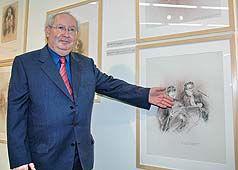.jpg?itok=cgJ__GWw)
The defendant, Klaus Barbie, arrives at the defendant's bench

Atty. Serge Klarsfeld points to himself in Diaz's sketch from the Barbie trial.
.jpg?itok=rCoZlFHT)
The author Elie Wiesel
.jpg?itok=Xj70qpmQ)
Atty. Sylvia Zimmerman and Atty. Serge Klarsfeld
17 October 2006
A new display of sketches drawn by the French artist René Diaz at the trial of war criminal Klaus Barbie will open in the foyer of Yad Vashem’s main auditorium on 17 October 2006. The opening will coincide with a symposium about the influence of the Klaus Barbie trial on Shoah remembrance in France, with the participation of Nazi hunter Serge Klarsfeld, who was responsible for Barbie’s eventual capture in 1983, the artist René Diaz, the Chairman of the French Society for Yad Vashem Dr. Richard Prasquier and Professor Tobie T. Nathan.
Klaus Barbie was born in 1913 in Bad Godesberg, Germany. He joined the Nazi party in 1932, and in 1935 the S.S. and the S.D. When the Germans invaded southern France in 1942, Barbie was appointed as head of the Gestapo in Lyon, where he commanded operations involving the arrest, torture, murder and deportation of thousands of Jews and underground fighters. Barbie’s inconceivable cruelty earned him the infamous title “the Butcher of Lyon.” After the war, Barbie worked as an agent for American counter-intelligence in Germany, and in 1951, he immigrated to Bolivia and settled in the capital, La Paz, adopting a false name, Klaus Altman.
In 1952 and 1954, Barbie was tried in absentia in France, and found guilty on both accounts. In 1971, Nazi hunters Beate and Serge Klarsfeld tracked him down. Unfortunately, requests for extradition were denied several times. Only in 1983 was Barbie successfully deported from Bolivia to France. He was charged with crimes against humanity, crimes for which the statute of limitations does not apply. They included responsibility for: the February 1943 raid on the General Union of French Jewry, during which 85 Jews were arrested and transported to Auschwitz; the deportation of 44 Jewish children hiding in the village of Izieu, near Lyon; and the last transport of Jews from Lyon to Auschwitz in 1944. Barbie was also accused of deporting 842 members of the French underground (the Rèsistance) – half of which were Jewish – from Lyon, as well as for the torture and the murder of Jean Moulin, a prominent member of the Rèsistance.
On 4 July 1987, Klaus Barbie was found guilty of crimes against humanity, and sentenced to life in prison, the maximum penalty permitted under French law. In 1991, Barbie died of cancer, in prison.
The sketches on display are part of a larger collection drawn by René Diaz, during the 8 weeks of Barbie’s trial in 1987, and then touched up in 1993. The sketches were previously displayed at the Musee de la Deportation et Resistance de Lyon. After the exhibition closed, Diaz generously donated the drawings to Yad Vashem.






